Business Analysis and Reflective Report: Oxford University Press
VerifiedAdded on 2022/12/26
|11
|3153
|30
Report
AI Summary
This report provides a comprehensive business analysis of Oxford University Press (OUP), a leading publishing house. It begins with an overview of the publishing industry in the UK, including industry data, key businesses, customers, suppliers, and competitors. The report then delves into a detailed analysis of OUP's strengths, weaknesses, performance, and challenges. Furthermore, it applies PESTEL and Porter's Five Forces models to assess the external and competitive environments, identifying political, economic, social, technological, environmental, and legal factors, as well as competitive dynamics within the industry. The report also addresses specific issues faced by OUP, such as the impact of the COVID-19 pandemic and the shift to digital environments. Finally, the report includes a reflective section, focusing on key skill development during the assignment, using Gibbs' Reflective Cycle to analyze the learning experience and identify areas for improvement in areas like communication, problem-solving and team work. The report concludes with a synthesis of findings and recommendations for OUP.
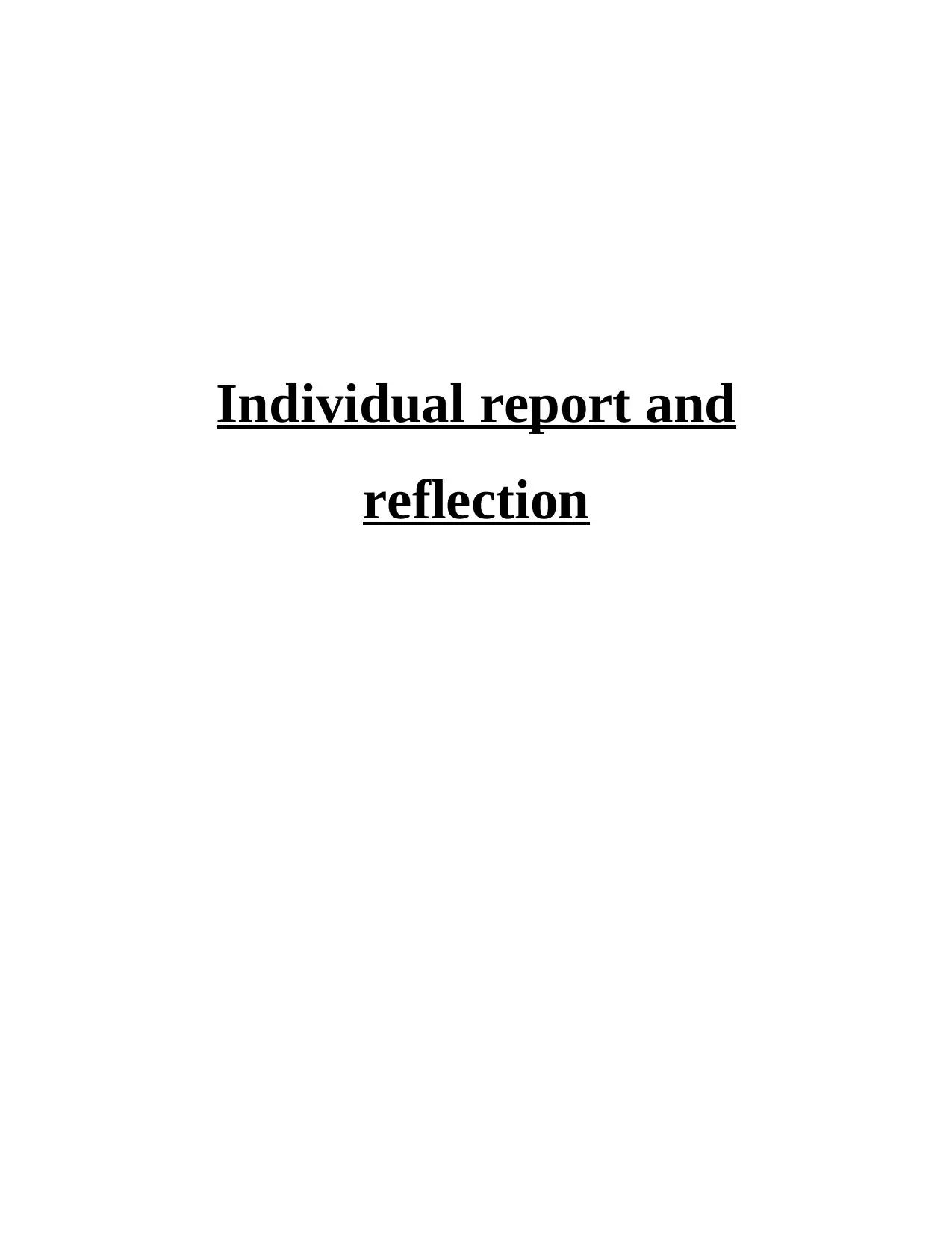
Individual report and
reflection
reflection
Paraphrase This Document
Need a fresh take? Get an instant paraphrase of this document with our AI Paraphraser
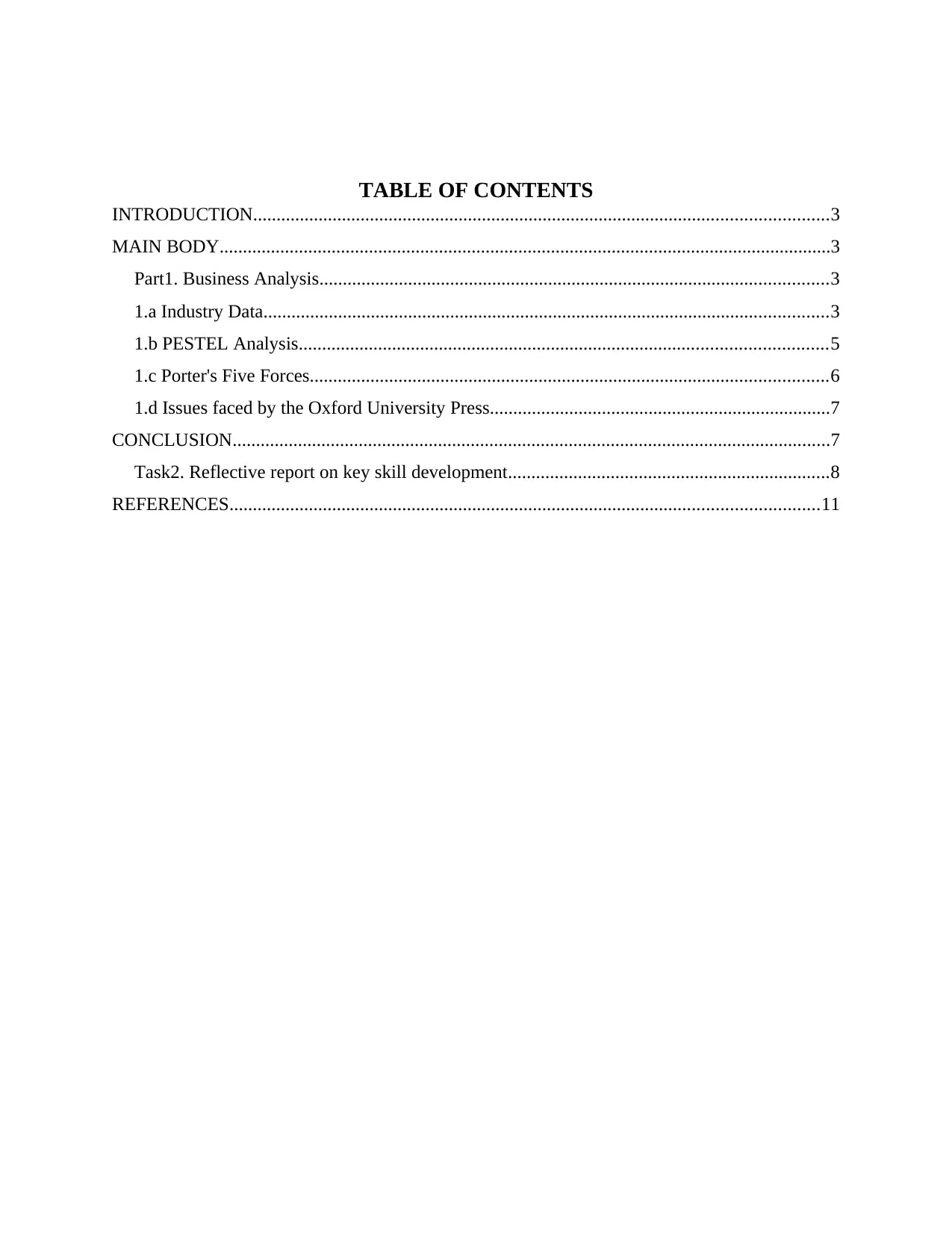
TABLE OF CONTENTS
INTRODUCTION...........................................................................................................................3
MAIN BODY...................................................................................................................................3
Part1. Business Analysis.............................................................................................................3
1.a Industry Data.........................................................................................................................3
1.b PESTEL Analysis.................................................................................................................5
1.c Porter's Five Forces...............................................................................................................6
1.d Issues faced by the Oxford University Press.........................................................................7
CONCLUSION................................................................................................................................7
Task2. Reflective report on key skill development.....................................................................8
REFERENCES..............................................................................................................................11
INTRODUCTION...........................................................................................................................3
MAIN BODY...................................................................................................................................3
Part1. Business Analysis.............................................................................................................3
1.a Industry Data.........................................................................................................................3
1.b PESTEL Analysis.................................................................................................................5
1.c Porter's Five Forces...............................................................................................................6
1.d Issues faced by the Oxford University Press.........................................................................7
CONCLUSION................................................................................................................................7
Task2. Reflective report on key skill development.....................................................................8
REFERENCES..............................................................................................................................11
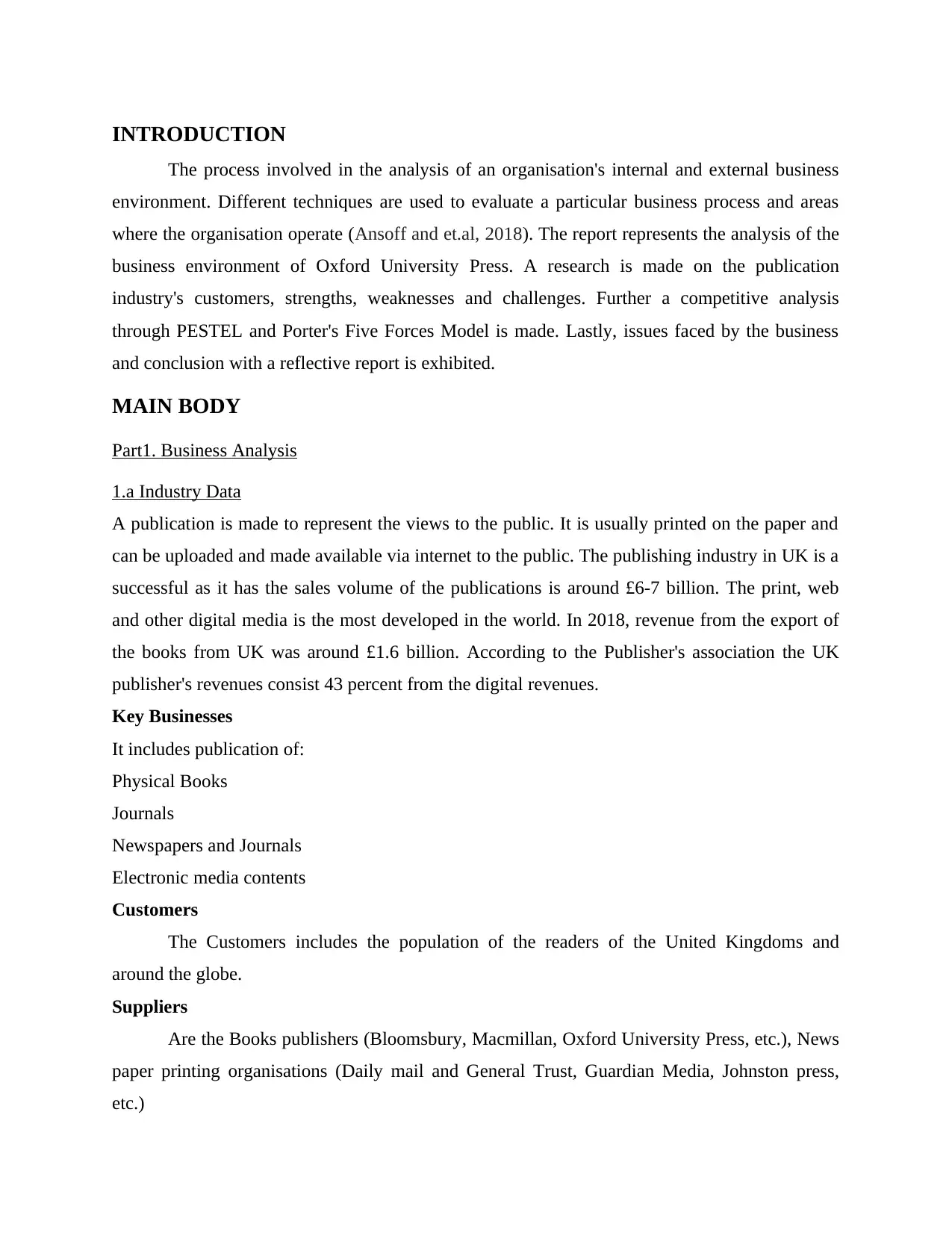
INTRODUCTION
The process involved in the analysis of an organisation's internal and external business
environment. Different techniques are used to evaluate a particular business process and areas
where the organisation operate (Ansoff and et.al, 2018). The report represents the analysis of the
business environment of Oxford University Press. A research is made on the publication
industry's customers, strengths, weaknesses and challenges. Further a competitive analysis
through PESTEL and Porter's Five Forces Model is made. Lastly, issues faced by the business
and conclusion with a reflective report is exhibited.
MAIN BODY
Part1. Business Analysis
1.a Industry Data
A publication is made to represent the views to the public. It is usually printed on the paper and
can be uploaded and made available via internet to the public. The publishing industry in UK is a
successful as it has the sales volume of the publications is around £6-7 billion. The print, web
and other digital media is the most developed in the world. In 2018, revenue from the export of
the books from UK was around £1.6 billion. According to the Publisher's association the UK
publisher's revenues consist 43 percent from the digital revenues.
Key Businesses
It includes publication of:
Physical Books
Journals
Newspapers and Journals
Electronic media contents
Customers
The Customers includes the population of the readers of the United Kingdoms and
around the globe.
Suppliers
Are the Books publishers (Bloomsbury, Macmillan, Oxford University Press, etc.), News
paper printing organisations (Daily mail and General Trust, Guardian Media, Johnston press,
etc.)
The process involved in the analysis of an organisation's internal and external business
environment. Different techniques are used to evaluate a particular business process and areas
where the organisation operate (Ansoff and et.al, 2018). The report represents the analysis of the
business environment of Oxford University Press. A research is made on the publication
industry's customers, strengths, weaknesses and challenges. Further a competitive analysis
through PESTEL and Porter's Five Forces Model is made. Lastly, issues faced by the business
and conclusion with a reflective report is exhibited.
MAIN BODY
Part1. Business Analysis
1.a Industry Data
A publication is made to represent the views to the public. It is usually printed on the paper and
can be uploaded and made available via internet to the public. The publishing industry in UK is a
successful as it has the sales volume of the publications is around £6-7 billion. The print, web
and other digital media is the most developed in the world. In 2018, revenue from the export of
the books from UK was around £1.6 billion. According to the Publisher's association the UK
publisher's revenues consist 43 percent from the digital revenues.
Key Businesses
It includes publication of:
Physical Books
Journals
Newspapers and Journals
Electronic media contents
Customers
The Customers includes the population of the readers of the United Kingdoms and
around the globe.
Suppliers
Are the Books publishers (Bloomsbury, Macmillan, Oxford University Press, etc.), News
paper printing organisations (Daily mail and General Trust, Guardian Media, Johnston press,
etc.)
⊘ This is a preview!⊘
Do you want full access?
Subscribe today to unlock all pages.

Trusted by 1+ million students worldwide
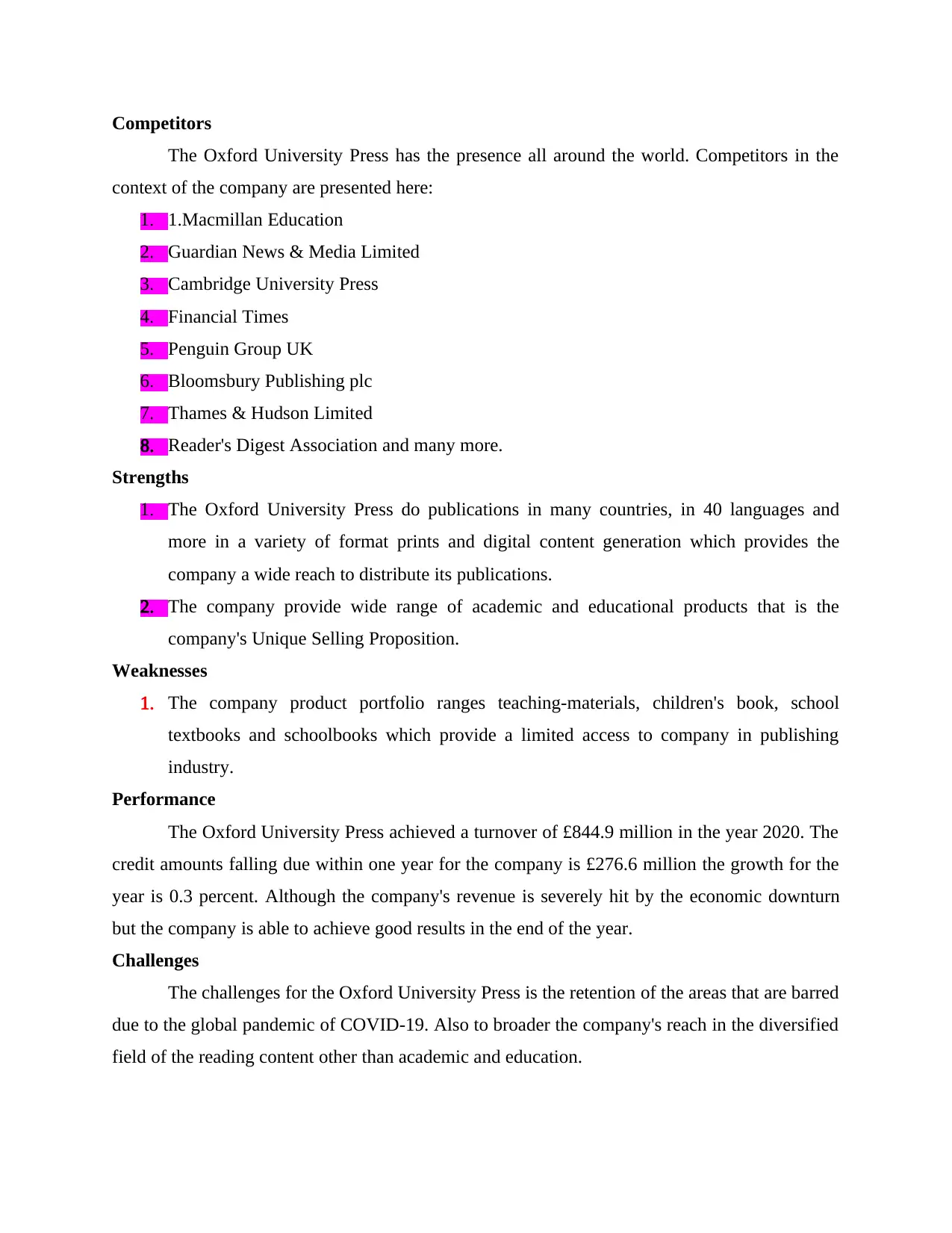
Competitors
The Oxford University Press has the presence all around the world. Competitors in the
context of the company are presented here:
1. 1.Macmillan Education
2. Guardian News & Media Limited
3. Cambridge University Press
4. Financial Times
5. Penguin Group UK
6. Bloomsbury Publishing plc
7. Thames & Hudson Limited
8. Reader's Digest Association and many more.
Strengths
1. The Oxford University Press do publications in many countries, in 40 languages and
more in a variety of format prints and digital content generation which provides the
company a wide reach to distribute its publications.
2. The company provide wide range of academic and educational products that is the
company's Unique Selling Proposition.
Weaknesses
1. The company product portfolio ranges teaching-materials, children's book, school
textbooks and schoolbooks which provide a limited access to company in publishing
industry.
Performance
The Oxford University Press achieved a turnover of £844.9 million in the year 2020. The
credit amounts falling due within one year for the company is £276.6 million the growth for the
year is 0.3 percent. Although the company's revenue is severely hit by the economic downturn
but the company is able to achieve good results in the end of the year.
Challenges
The challenges for the Oxford University Press is the retention of the areas that are barred
due to the global pandemic of COVID-19. Also to broader the company's reach in the diversified
field of the reading content other than academic and education.
The Oxford University Press has the presence all around the world. Competitors in the
context of the company are presented here:
1. 1.Macmillan Education
2. Guardian News & Media Limited
3. Cambridge University Press
4. Financial Times
5. Penguin Group UK
6. Bloomsbury Publishing plc
7. Thames & Hudson Limited
8. Reader's Digest Association and many more.
Strengths
1. The Oxford University Press do publications in many countries, in 40 languages and
more in a variety of format prints and digital content generation which provides the
company a wide reach to distribute its publications.
2. The company provide wide range of academic and educational products that is the
company's Unique Selling Proposition.
Weaknesses
1. The company product portfolio ranges teaching-materials, children's book, school
textbooks and schoolbooks which provide a limited access to company in publishing
industry.
Performance
The Oxford University Press achieved a turnover of £844.9 million in the year 2020. The
credit amounts falling due within one year for the company is £276.6 million the growth for the
year is 0.3 percent. Although the company's revenue is severely hit by the economic downturn
but the company is able to achieve good results in the end of the year.
Challenges
The challenges for the Oxford University Press is the retention of the areas that are barred
due to the global pandemic of COVID-19. Also to broader the company's reach in the diversified
field of the reading content other than academic and education.
Paraphrase This Document
Need a fresh take? Get an instant paraphrase of this document with our AI Paraphraser
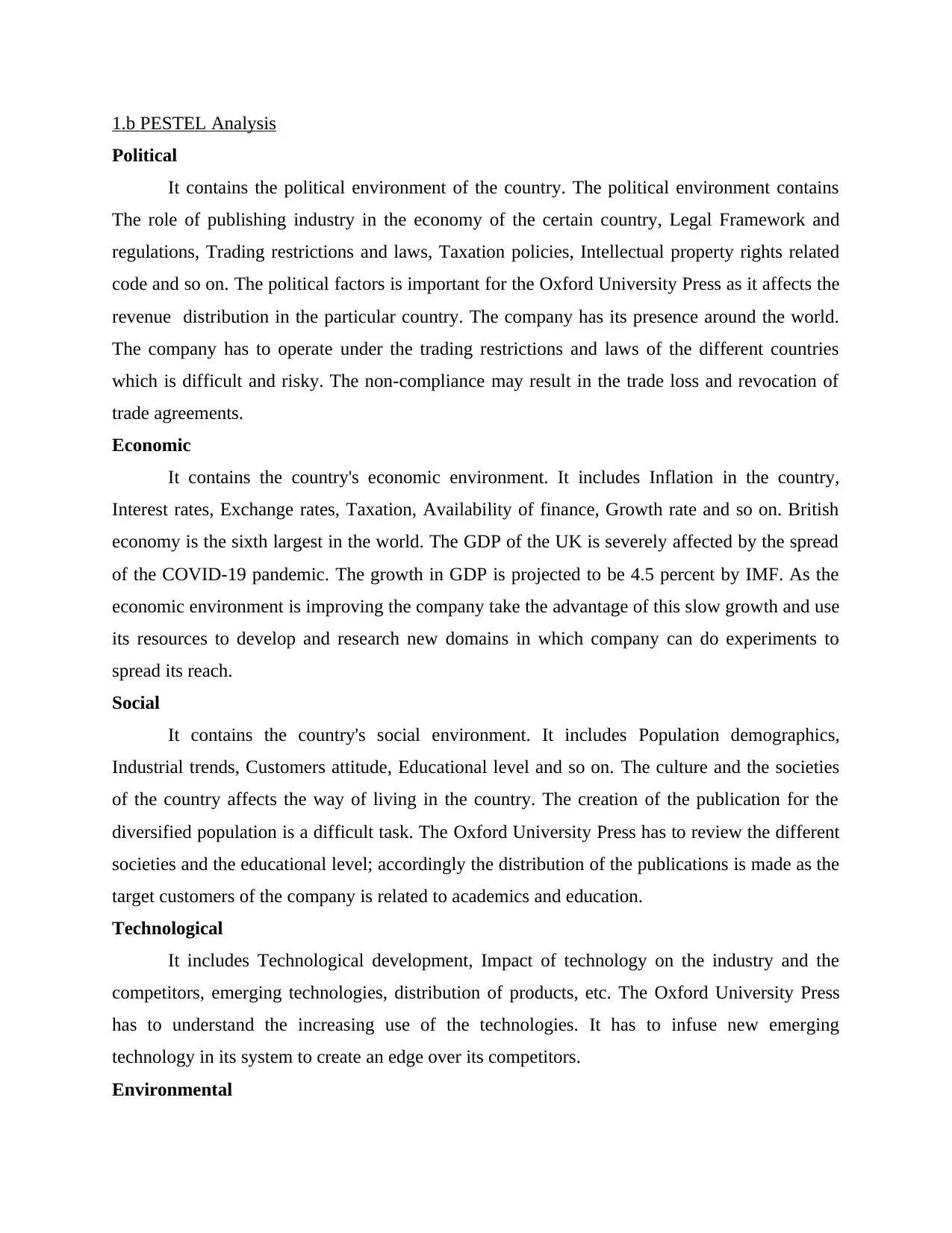
1.b PESTEL Analysis
Political
It contains the political environment of the country. The political environment contains
The role of publishing industry in the economy of the certain country, Legal Framework and
regulations, Trading restrictions and laws, Taxation policies, Intellectual property rights related
code and so on. The political factors is important for the Oxford University Press as it affects the
revenue distribution in the particular country. The company has its presence around the world.
The company has to operate under the trading restrictions and laws of the different countries
which is difficult and risky. The non-compliance may result in the trade loss and revocation of
trade agreements.
Economic
It contains the country's economic environment. It includes Inflation in the country,
Interest rates, Exchange rates, Taxation, Availability of finance, Growth rate and so on. British
economy is the sixth largest in the world. The GDP of the UK is severely affected by the spread
of the COVID-19 pandemic. The growth in GDP is projected to be 4.5 percent by IMF. As the
economic environment is improving the company take the advantage of this slow growth and use
its resources to develop and research new domains in which company can do experiments to
spread its reach.
Social
It contains the country's social environment. It includes Population demographics,
Industrial trends, Customers attitude, Educational level and so on. The culture and the societies
of the country affects the way of living in the country. The creation of the publication for the
diversified population is a difficult task. The Oxford University Press has to review the different
societies and the educational level; accordingly the distribution of the publications is made as the
target customers of the company is related to academics and education.
Technological
It includes Technological development, Impact of technology on the industry and the
competitors, emerging technologies, distribution of products, etc. The Oxford University Press
has to understand the increasing use of the technologies. It has to infuse new emerging
technology in its system to create an edge over its competitors.
Environmental
Political
It contains the political environment of the country. The political environment contains
The role of publishing industry in the economy of the certain country, Legal Framework and
regulations, Trading restrictions and laws, Taxation policies, Intellectual property rights related
code and so on. The political factors is important for the Oxford University Press as it affects the
revenue distribution in the particular country. The company has its presence around the world.
The company has to operate under the trading restrictions and laws of the different countries
which is difficult and risky. The non-compliance may result in the trade loss and revocation of
trade agreements.
Economic
It contains the country's economic environment. It includes Inflation in the country,
Interest rates, Exchange rates, Taxation, Availability of finance, Growth rate and so on. British
economy is the sixth largest in the world. The GDP of the UK is severely affected by the spread
of the COVID-19 pandemic. The growth in GDP is projected to be 4.5 percent by IMF. As the
economic environment is improving the company take the advantage of this slow growth and use
its resources to develop and research new domains in which company can do experiments to
spread its reach.
Social
It contains the country's social environment. It includes Population demographics,
Industrial trends, Customers attitude, Educational level and so on. The culture and the societies
of the country affects the way of living in the country. The creation of the publication for the
diversified population is a difficult task. The Oxford University Press has to review the different
societies and the educational level; accordingly the distribution of the publications is made as the
target customers of the company is related to academics and education.
Technological
It includes Technological development, Impact of technology on the industry and the
competitors, emerging technologies, distribution of products, etc. The Oxford University Press
has to understand the increasing use of the technologies. It has to infuse new emerging
technology in its system to create an edge over its competitors.
Environmental
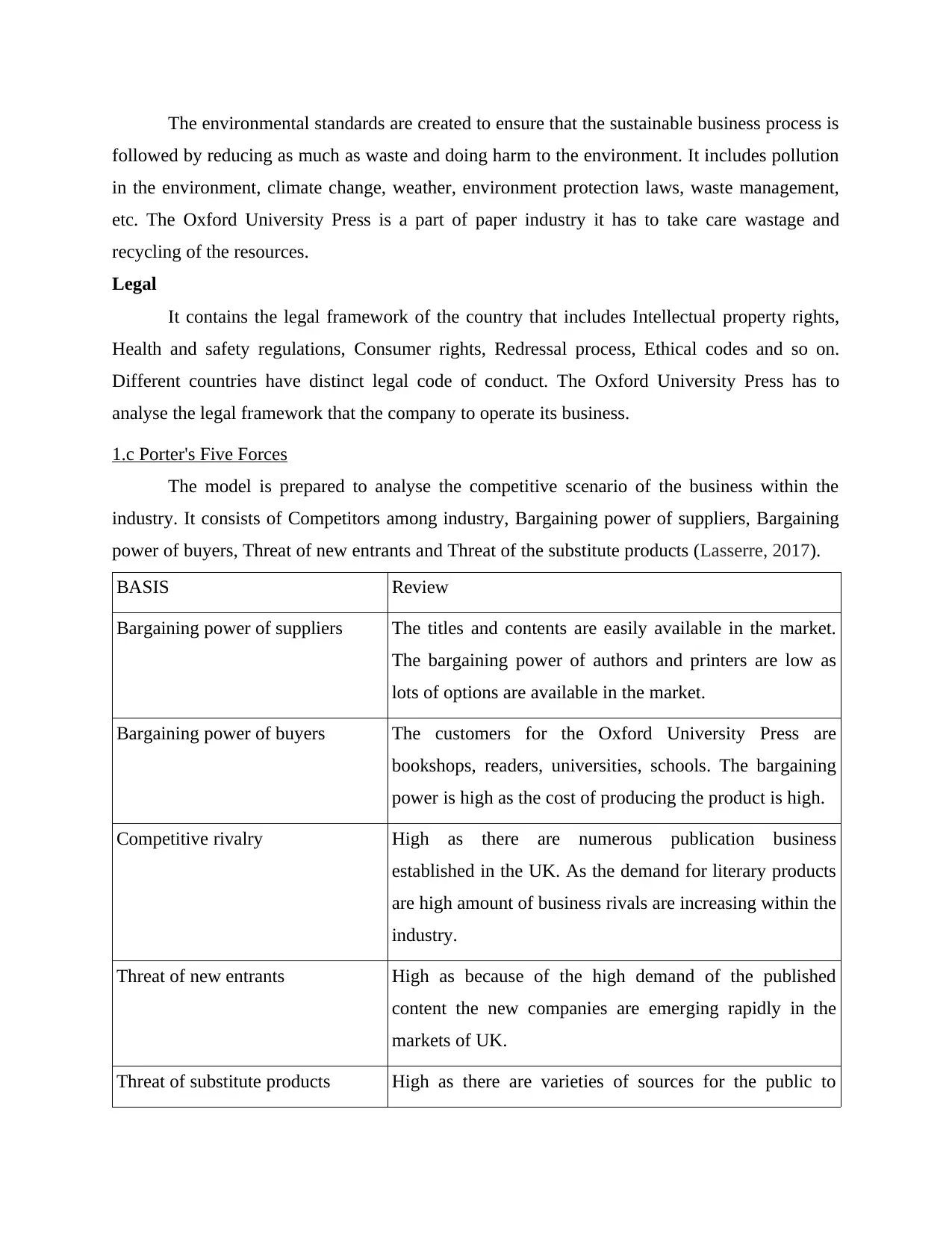
The environmental standards are created to ensure that the sustainable business process is
followed by reducing as much as waste and doing harm to the environment. It includes pollution
in the environment, climate change, weather, environment protection laws, waste management,
etc. The Oxford University Press is a part of paper industry it has to take care wastage and
recycling of the resources.
Legal
It contains the legal framework of the country that includes Intellectual property rights,
Health and safety regulations, Consumer rights, Redressal process, Ethical codes and so on.
Different countries have distinct legal code of conduct. The Oxford University Press has to
analyse the legal framework that the company to operate its business.
1.c Porter's Five Forces
The model is prepared to analyse the competitive scenario of the business within the
industry. It consists of Competitors among industry, Bargaining power of suppliers, Bargaining
power of buyers, Threat of new entrants and Threat of the substitute products (Lasserre, 2017).
BASIS Review
Bargaining power of suppliers The titles and contents are easily available in the market.
The bargaining power of authors and printers are low as
lots of options are available in the market.
Bargaining power of buyers The customers for the Oxford University Press are
bookshops, readers, universities, schools. The bargaining
power is high as the cost of producing the product is high.
Competitive rivalry High as there are numerous publication business
established in the UK. As the demand for literary products
are high amount of business rivals are increasing within the
industry.
Threat of new entrants High as because of the high demand of the published
content the new companies are emerging rapidly in the
markets of UK.
Threat of substitute products High as there are varieties of sources for the public to
followed by reducing as much as waste and doing harm to the environment. It includes pollution
in the environment, climate change, weather, environment protection laws, waste management,
etc. The Oxford University Press is a part of paper industry it has to take care wastage and
recycling of the resources.
Legal
It contains the legal framework of the country that includes Intellectual property rights,
Health and safety regulations, Consumer rights, Redressal process, Ethical codes and so on.
Different countries have distinct legal code of conduct. The Oxford University Press has to
analyse the legal framework that the company to operate its business.
1.c Porter's Five Forces
The model is prepared to analyse the competitive scenario of the business within the
industry. It consists of Competitors among industry, Bargaining power of suppliers, Bargaining
power of buyers, Threat of new entrants and Threat of the substitute products (Lasserre, 2017).
BASIS Review
Bargaining power of suppliers The titles and contents are easily available in the market.
The bargaining power of authors and printers are low as
lots of options are available in the market.
Bargaining power of buyers The customers for the Oxford University Press are
bookshops, readers, universities, schools. The bargaining
power is high as the cost of producing the product is high.
Competitive rivalry High as there are numerous publication business
established in the UK. As the demand for literary products
are high amount of business rivals are increasing within the
industry.
Threat of new entrants High as because of the high demand of the published
content the new companies are emerging rapidly in the
markets of UK.
Threat of substitute products High as there are varieties of sources for the public to
⊘ This is a preview!⊘
Do you want full access?
Subscribe today to unlock all pages.

Trusted by 1+ million students worldwide
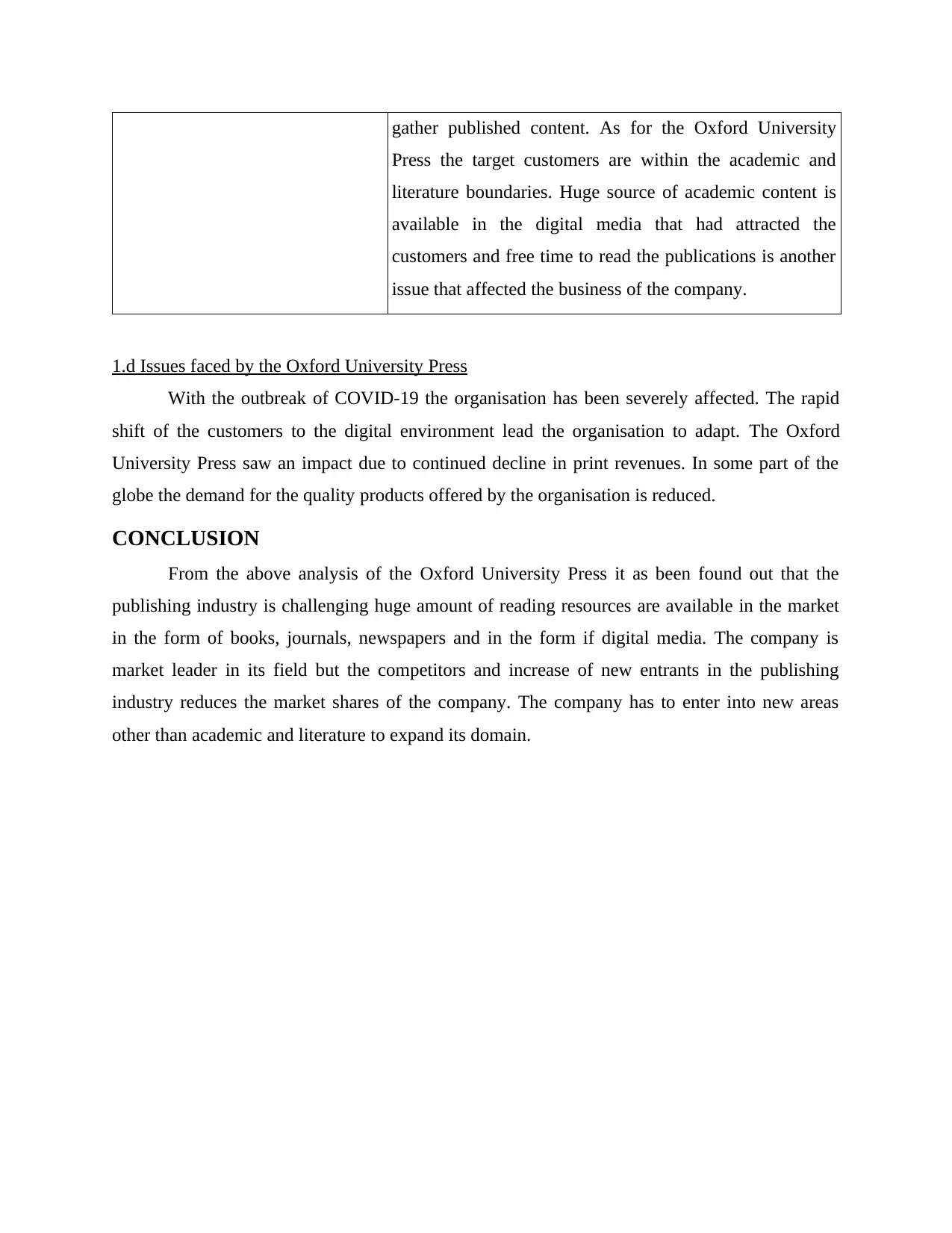
gather published content. As for the Oxford University
Press the target customers are within the academic and
literature boundaries. Huge source of academic content is
available in the digital media that had attracted the
customers and free time to read the publications is another
issue that affected the business of the company.
1.d Issues faced by the Oxford University Press
With the outbreak of COVID-19 the organisation has been severely affected. The rapid
shift of the customers to the digital environment lead the organisation to adapt. The Oxford
University Press saw an impact due to continued decline in print revenues. In some part of the
globe the demand for the quality products offered by the organisation is reduced.
CONCLUSION
From the above analysis of the Oxford University Press it as been found out that the
publishing industry is challenging huge amount of reading resources are available in the market
in the form of books, journals, newspapers and in the form if digital media. The company is
market leader in its field but the competitors and increase of new entrants in the publishing
industry reduces the market shares of the company. The company has to enter into new areas
other than academic and literature to expand its domain.
Press the target customers are within the academic and
literature boundaries. Huge source of academic content is
available in the digital media that had attracted the
customers and free time to read the publications is another
issue that affected the business of the company.
1.d Issues faced by the Oxford University Press
With the outbreak of COVID-19 the organisation has been severely affected. The rapid
shift of the customers to the digital environment lead the organisation to adapt. The Oxford
University Press saw an impact due to continued decline in print revenues. In some part of the
globe the demand for the quality products offered by the organisation is reduced.
CONCLUSION
From the above analysis of the Oxford University Press it as been found out that the
publishing industry is challenging huge amount of reading resources are available in the market
in the form of books, journals, newspapers and in the form if digital media. The company is
market leader in its field but the competitors and increase of new entrants in the publishing
industry reduces the market shares of the company. The company has to enter into new areas
other than academic and literature to expand its domain.
Paraphrase This Document
Need a fresh take? Get an instant paraphrase of this document with our AI Paraphraser
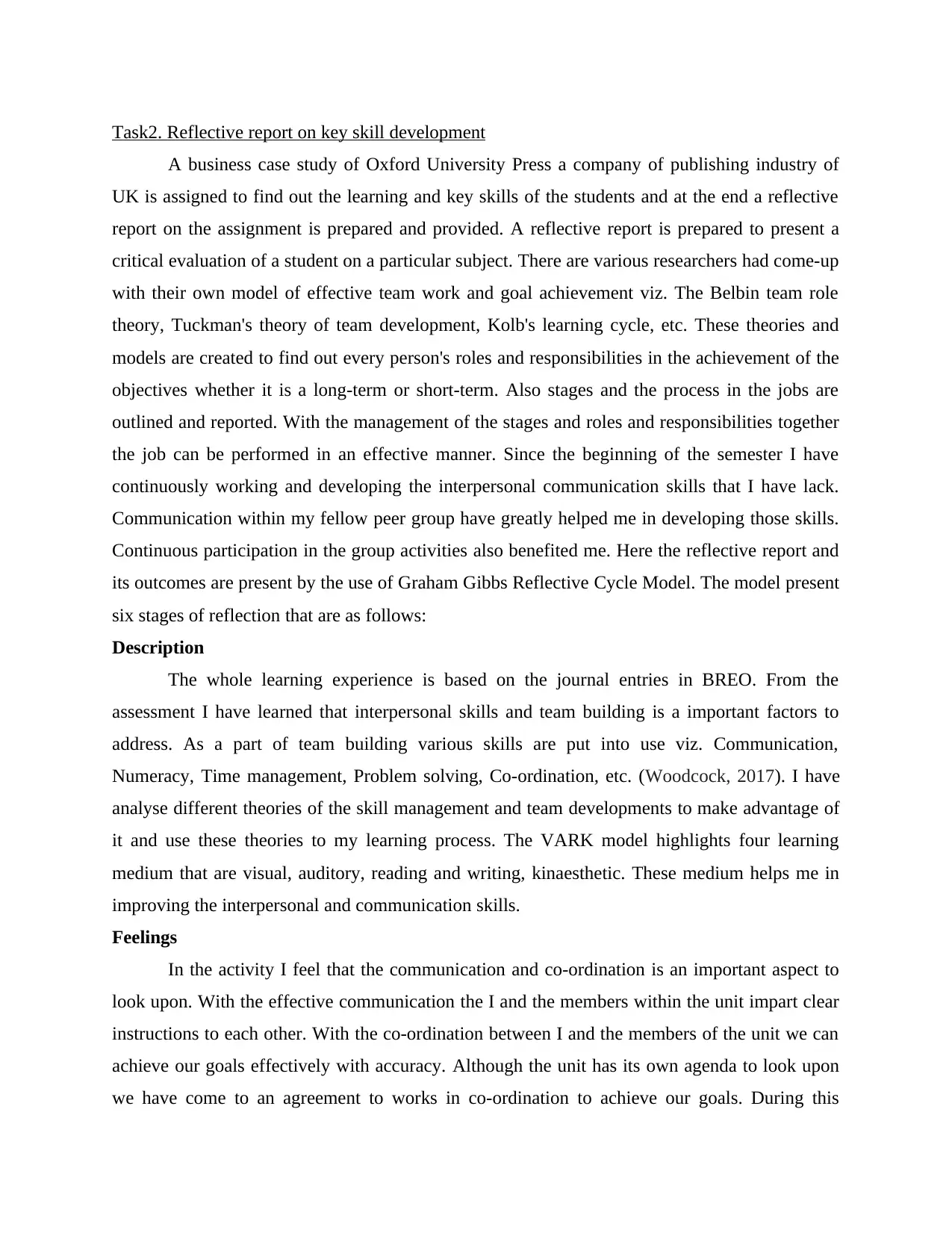
Task2. Reflective report on key skill development
A business case study of Oxford University Press a company of publishing industry of
UK is assigned to find out the learning and key skills of the students and at the end a reflective
report on the assignment is prepared and provided. A reflective report is prepared to present a
critical evaluation of a student on a particular subject. There are various researchers had come-up
with their own model of effective team work and goal achievement viz. The Belbin team role
theory, Tuckman's theory of team development, Kolb's learning cycle, etc. These theories and
models are created to find out every person's roles and responsibilities in the achievement of the
objectives whether it is a long-term or short-term. Also stages and the process in the jobs are
outlined and reported. With the management of the stages and roles and responsibilities together
the job can be performed in an effective manner. Since the beginning of the semester I have
continuously working and developing the interpersonal communication skills that I have lack.
Communication within my fellow peer group have greatly helped me in developing those skills.
Continuous participation in the group activities also benefited me. Here the reflective report and
its outcomes are present by the use of Graham Gibbs Reflective Cycle Model. The model present
six stages of reflection that are as follows:
Description
The whole learning experience is based on the journal entries in BREO. From the
assessment I have learned that interpersonal skills and team building is a important factors to
address. As a part of team building various skills are put into use viz. Communication,
Numeracy, Time management, Problem solving, Co-ordination, etc. (Woodcock, 2017). I have
analyse different theories of the skill management and team developments to make advantage of
it and use these theories to my learning process. The VARK model highlights four learning
medium that are visual, auditory, reading and writing, kinaesthetic. These medium helps me in
improving the interpersonal and communication skills.
Feelings
In the activity I feel that the communication and co-ordination is an important aspect to
look upon. With the effective communication the I and the members within the unit impart clear
instructions to each other. With the co-ordination between I and the members of the unit we can
achieve our goals effectively with accuracy. Although the unit has its own agenda to look upon
we have come to an agreement to works in co-ordination to achieve our goals. During this
A business case study of Oxford University Press a company of publishing industry of
UK is assigned to find out the learning and key skills of the students and at the end a reflective
report on the assignment is prepared and provided. A reflective report is prepared to present a
critical evaluation of a student on a particular subject. There are various researchers had come-up
with their own model of effective team work and goal achievement viz. The Belbin team role
theory, Tuckman's theory of team development, Kolb's learning cycle, etc. These theories and
models are created to find out every person's roles and responsibilities in the achievement of the
objectives whether it is a long-term or short-term. Also stages and the process in the jobs are
outlined and reported. With the management of the stages and roles and responsibilities together
the job can be performed in an effective manner. Since the beginning of the semester I have
continuously working and developing the interpersonal communication skills that I have lack.
Communication within my fellow peer group have greatly helped me in developing those skills.
Continuous participation in the group activities also benefited me. Here the reflective report and
its outcomes are present by the use of Graham Gibbs Reflective Cycle Model. The model present
six stages of reflection that are as follows:
Description
The whole learning experience is based on the journal entries in BREO. From the
assessment I have learned that interpersonal skills and team building is a important factors to
address. As a part of team building various skills are put into use viz. Communication,
Numeracy, Time management, Problem solving, Co-ordination, etc. (Woodcock, 2017). I have
analyse different theories of the skill management and team developments to make advantage of
it and use these theories to my learning process. The VARK model highlights four learning
medium that are visual, auditory, reading and writing, kinaesthetic. These medium helps me in
improving the interpersonal and communication skills.
Feelings
In the activity I feel that the communication and co-ordination is an important aspect to
look upon. With the effective communication the I and the members within the unit impart clear
instructions to each other. With the co-ordination between I and the members of the unit we can
achieve our goals effectively with accuracy. Although the unit has its own agenda to look upon
we have come to an agreement to works in co-ordination to achieve our goals. During this
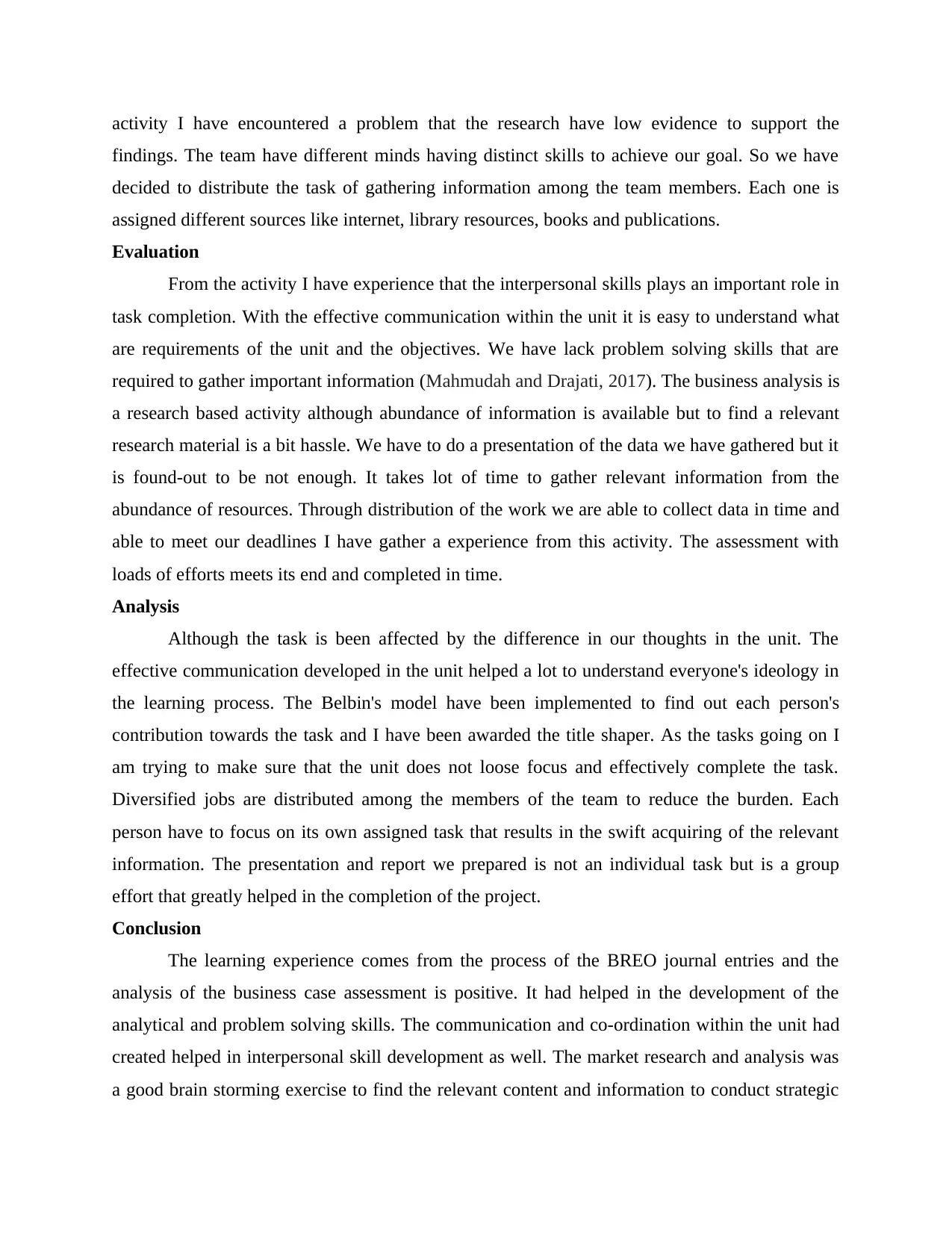
activity I have encountered a problem that the research have low evidence to support the
findings. The team have different minds having distinct skills to achieve our goal. So we have
decided to distribute the task of gathering information among the team members. Each one is
assigned different sources like internet, library resources, books and publications.
Evaluation
From the activity I have experience that the interpersonal skills plays an important role in
task completion. With the effective communication within the unit it is easy to understand what
are requirements of the unit and the objectives. We have lack problem solving skills that are
required to gather important information (Mahmudah and Drajati, 2017). The business analysis is
a research based activity although abundance of information is available but to find a relevant
research material is a bit hassle. We have to do a presentation of the data we have gathered but it
is found-out to be not enough. It takes lot of time to gather relevant information from the
abundance of resources. Through distribution of the work we are able to collect data in time and
able to meet our deadlines I have gather a experience from this activity. The assessment with
loads of efforts meets its end and completed in time.
Analysis
Although the task is been affected by the difference in our thoughts in the unit. The
effective communication developed in the unit helped a lot to understand everyone's ideology in
the learning process. The Belbin's model have been implemented to find out each person's
contribution towards the task and I have been awarded the title shaper. As the tasks going on I
am trying to make sure that the unit does not loose focus and effectively complete the task.
Diversified jobs are distributed among the members of the team to reduce the burden. Each
person have to focus on its own assigned task that results in the swift acquiring of the relevant
information. The presentation and report we prepared is not an individual task but is a group
effort that greatly helped in the completion of the project.
Conclusion
The learning experience comes from the process of the BREO journal entries and the
analysis of the business case assessment is positive. It had helped in the development of the
analytical and problem solving skills. The communication and co-ordination within the unit had
created helped in interpersonal skill development as well. The market research and analysis was
a good brain storming exercise to find the relevant content and information to conduct strategic
findings. The team have different minds having distinct skills to achieve our goal. So we have
decided to distribute the task of gathering information among the team members. Each one is
assigned different sources like internet, library resources, books and publications.
Evaluation
From the activity I have experience that the interpersonal skills plays an important role in
task completion. With the effective communication within the unit it is easy to understand what
are requirements of the unit and the objectives. We have lack problem solving skills that are
required to gather important information (Mahmudah and Drajati, 2017). The business analysis is
a research based activity although abundance of information is available but to find a relevant
research material is a bit hassle. We have to do a presentation of the data we have gathered but it
is found-out to be not enough. It takes lot of time to gather relevant information from the
abundance of resources. Through distribution of the work we are able to collect data in time and
able to meet our deadlines I have gather a experience from this activity. The assessment with
loads of efforts meets its end and completed in time.
Analysis
Although the task is been affected by the difference in our thoughts in the unit. The
effective communication developed in the unit helped a lot to understand everyone's ideology in
the learning process. The Belbin's model have been implemented to find out each person's
contribution towards the task and I have been awarded the title shaper. As the tasks going on I
am trying to make sure that the unit does not loose focus and effectively complete the task.
Diversified jobs are distributed among the members of the team to reduce the burden. Each
person have to focus on its own assigned task that results in the swift acquiring of the relevant
information. The presentation and report we prepared is not an individual task but is a group
effort that greatly helped in the completion of the project.
Conclusion
The learning experience comes from the process of the BREO journal entries and the
analysis of the business case assessment is positive. It had helped in the development of the
analytical and problem solving skills. The communication and co-ordination within the unit had
created helped in interpersonal skill development as well. The market research and analysis was
a good brain storming exercise to find the relevant content and information to conduct strategic
⊘ This is a preview!⊘
Do you want full access?
Subscribe today to unlock all pages.

Trusted by 1+ million students worldwide
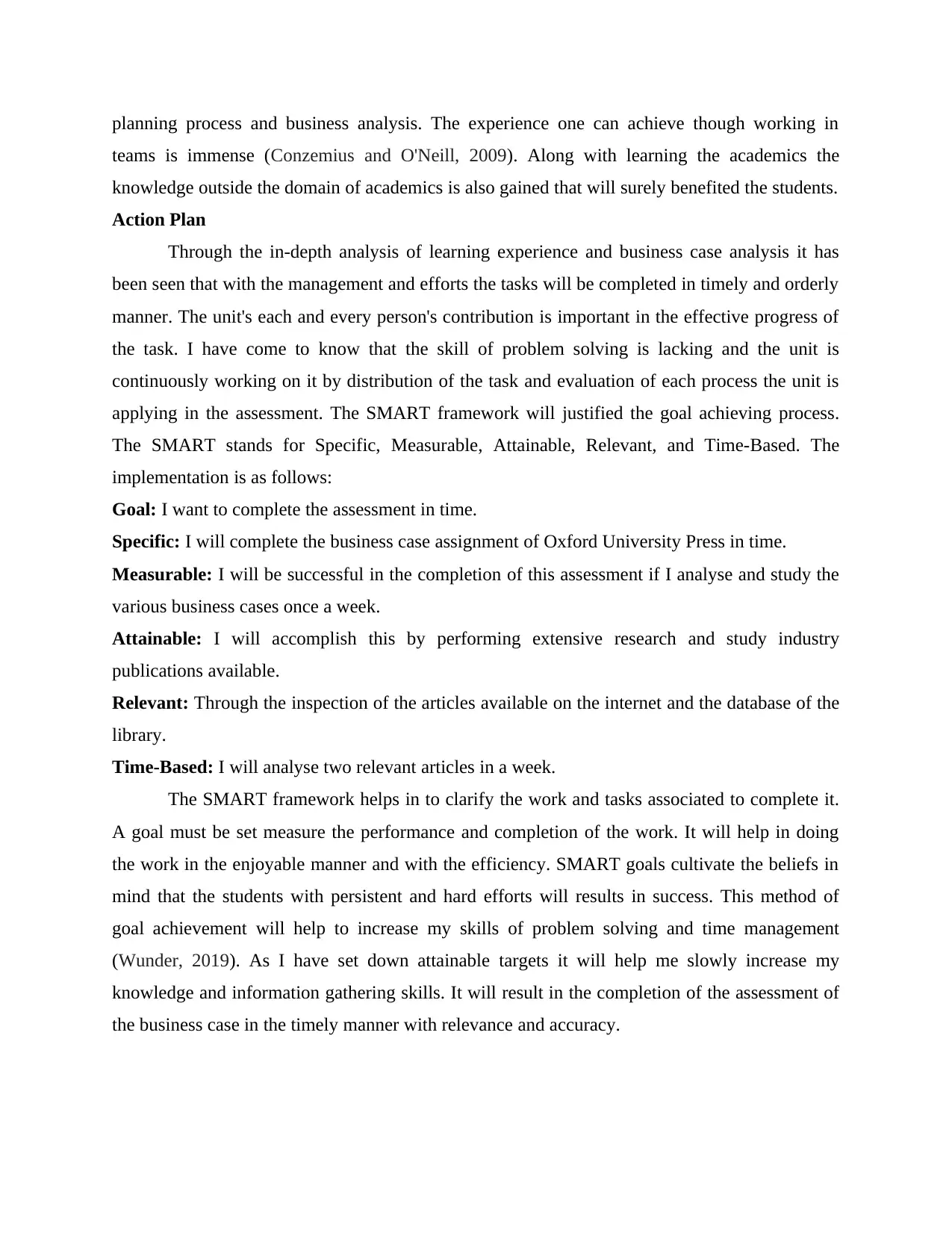
planning process and business analysis. The experience one can achieve though working in
teams is immense (Conzemius and O'Neill, 2009). Along with learning the academics the
knowledge outside the domain of academics is also gained that will surely benefited the students.
Action Plan
Through the in-depth analysis of learning experience and business case analysis it has
been seen that with the management and efforts the tasks will be completed in timely and orderly
manner. The unit's each and every person's contribution is important in the effective progress of
the task. I have come to know that the skill of problem solving is lacking and the unit is
continuously working on it by distribution of the task and evaluation of each process the unit is
applying in the assessment. The SMART framework will justified the goal achieving process.
The SMART stands for Specific, Measurable, Attainable, Relevant, and Time-Based. The
implementation is as follows:
Goal: I want to complete the assessment in time.
Specific: I will complete the business case assignment of Oxford University Press in time.
Measurable: I will be successful in the completion of this assessment if I analyse and study the
various business cases once a week.
Attainable: I will accomplish this by performing extensive research and study industry
publications available.
Relevant: Through the inspection of the articles available on the internet and the database of the
library.
Time-Based: I will analyse two relevant articles in a week.
The SMART framework helps in to clarify the work and tasks associated to complete it.
A goal must be set measure the performance and completion of the work. It will help in doing
the work in the enjoyable manner and with the efficiency. SMART goals cultivate the beliefs in
mind that the students with persistent and hard efforts will results in success. This method of
goal achievement will help to increase my skills of problem solving and time management
(Wunder, 2019). As I have set down attainable targets it will help me slowly increase my
knowledge and information gathering skills. It will result in the completion of the assessment of
the business case in the timely manner with relevance and accuracy.
teams is immense (Conzemius and O'Neill, 2009). Along with learning the academics the
knowledge outside the domain of academics is also gained that will surely benefited the students.
Action Plan
Through the in-depth analysis of learning experience and business case analysis it has
been seen that with the management and efforts the tasks will be completed in timely and orderly
manner. The unit's each and every person's contribution is important in the effective progress of
the task. I have come to know that the skill of problem solving is lacking and the unit is
continuously working on it by distribution of the task and evaluation of each process the unit is
applying in the assessment. The SMART framework will justified the goal achieving process.
The SMART stands for Specific, Measurable, Attainable, Relevant, and Time-Based. The
implementation is as follows:
Goal: I want to complete the assessment in time.
Specific: I will complete the business case assignment of Oxford University Press in time.
Measurable: I will be successful in the completion of this assessment if I analyse and study the
various business cases once a week.
Attainable: I will accomplish this by performing extensive research and study industry
publications available.
Relevant: Through the inspection of the articles available on the internet and the database of the
library.
Time-Based: I will analyse two relevant articles in a week.
The SMART framework helps in to clarify the work and tasks associated to complete it.
A goal must be set measure the performance and completion of the work. It will help in doing
the work in the enjoyable manner and with the efficiency. SMART goals cultivate the beliefs in
mind that the students with persistent and hard efforts will results in success. This method of
goal achievement will help to increase my skills of problem solving and time management
(Wunder, 2019). As I have set down attainable targets it will help me slowly increase my
knowledge and information gathering skills. It will result in the completion of the assessment of
the business case in the timely manner with relevance and accuracy.
Paraphrase This Document
Need a fresh take? Get an instant paraphrase of this document with our AI Paraphraser
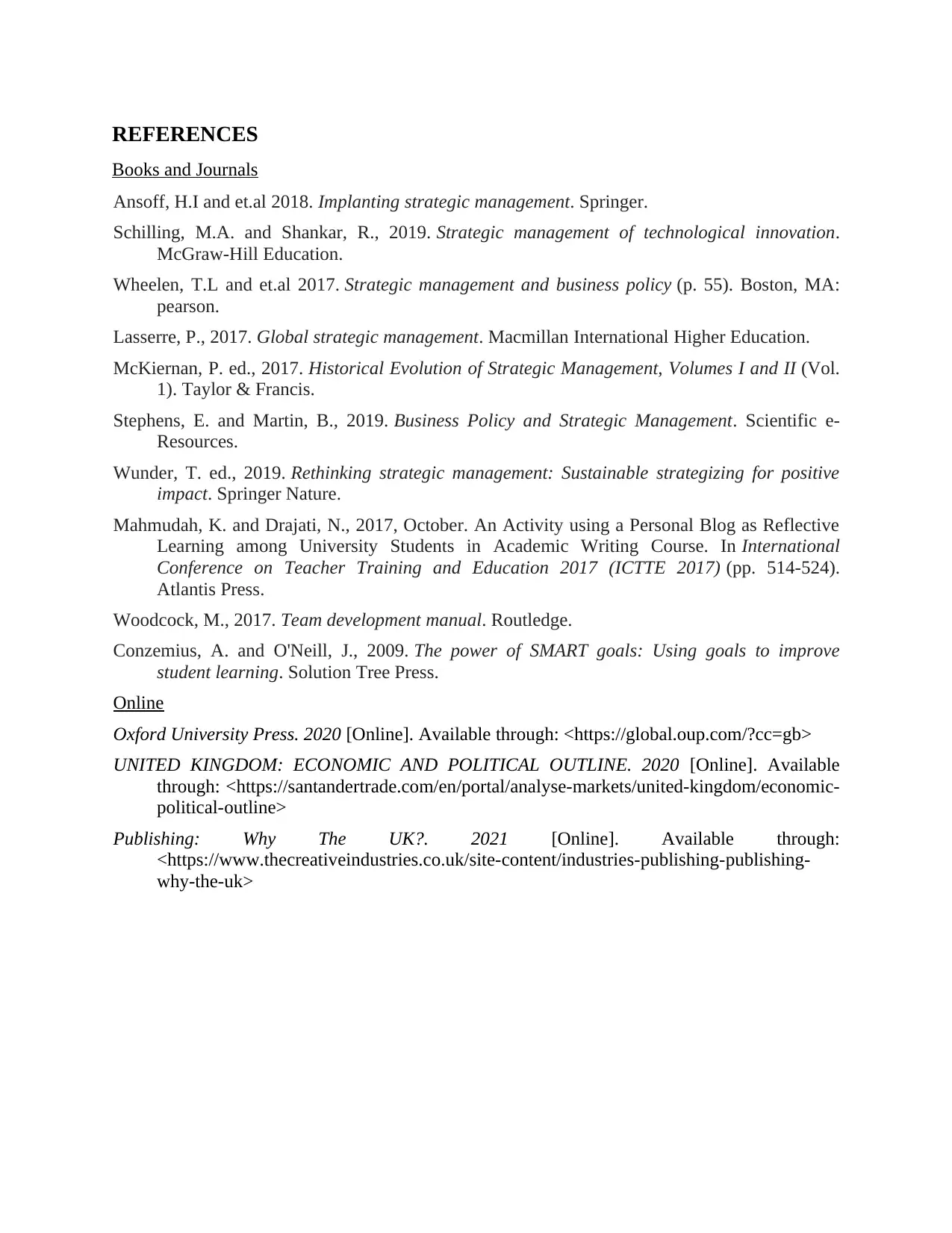
REFERENCES
Books and Journals
Ansoff, H.I and et.al 2018. Implanting strategic management. Springer.
Schilling, M.A. and Shankar, R., 2019. Strategic management of technological innovation.
McGraw-Hill Education.
Wheelen, T.L and et.al 2017. Strategic management and business policy (p. 55). Boston, MA:
pearson.
Lasserre, P., 2017. Global strategic management. Macmillan International Higher Education.
McKiernan, P. ed., 2017. Historical Evolution of Strategic Management, Volumes I and II (Vol.
1). Taylor & Francis.
Stephens, E. and Martin, B., 2019. Business Policy and Strategic Management. Scientific e-
Resources.
Wunder, T. ed., 2019. Rethinking strategic management: Sustainable strategizing for positive
impact. Springer Nature.
Mahmudah, K. and Drajati, N., 2017, October. An Activity using a Personal Blog as Reflective
Learning among University Students in Academic Writing Course. In International
Conference on Teacher Training and Education 2017 (ICTTE 2017) (pp. 514-524).
Atlantis Press.
Woodcock, M., 2017. Team development manual. Routledge.
Conzemius, A. and O'Neill, J., 2009. The power of SMART goals: Using goals to improve
student learning. Solution Tree Press.
Online
Oxford University Press. 2020 [Online]. Available through: <https://global.oup.com/?cc=gb>
UNITED KINGDOM: ECONOMIC AND POLITICAL OUTLINE. 2020 [Online]. Available
through: <https://santandertrade.com/en/portal/analyse-markets/united-kingdom/economic-
political-outline>
Publishing: Why The UK?. 2021 [Online]. Available through:
<https://www.thecreativeindustries.co.uk/site-content/industries-publishing-publishing-
why-the-uk>
Books and Journals
Ansoff, H.I and et.al 2018. Implanting strategic management. Springer.
Schilling, M.A. and Shankar, R., 2019. Strategic management of technological innovation.
McGraw-Hill Education.
Wheelen, T.L and et.al 2017. Strategic management and business policy (p. 55). Boston, MA:
pearson.
Lasserre, P., 2017. Global strategic management. Macmillan International Higher Education.
McKiernan, P. ed., 2017. Historical Evolution of Strategic Management, Volumes I and II (Vol.
1). Taylor & Francis.
Stephens, E. and Martin, B., 2019. Business Policy and Strategic Management. Scientific e-
Resources.
Wunder, T. ed., 2019. Rethinking strategic management: Sustainable strategizing for positive
impact. Springer Nature.
Mahmudah, K. and Drajati, N., 2017, October. An Activity using a Personal Blog as Reflective
Learning among University Students in Academic Writing Course. In International
Conference on Teacher Training and Education 2017 (ICTTE 2017) (pp. 514-524).
Atlantis Press.
Woodcock, M., 2017. Team development manual. Routledge.
Conzemius, A. and O'Neill, J., 2009. The power of SMART goals: Using goals to improve
student learning. Solution Tree Press.
Online
Oxford University Press. 2020 [Online]. Available through: <https://global.oup.com/?cc=gb>
UNITED KINGDOM: ECONOMIC AND POLITICAL OUTLINE. 2020 [Online]. Available
through: <https://santandertrade.com/en/portal/analyse-markets/united-kingdom/economic-
political-outline>
Publishing: Why The UK?. 2021 [Online]. Available through:
<https://www.thecreativeindustries.co.uk/site-content/industries-publishing-publishing-
why-the-uk>
1 out of 11
Related Documents
Your All-in-One AI-Powered Toolkit for Academic Success.
+13062052269
info@desklib.com
Available 24*7 on WhatsApp / Email
![[object Object]](/_next/static/media/star-bottom.7253800d.svg)
Unlock your academic potential
Copyright © 2020–2025 A2Z Services. All Rights Reserved. Developed and managed by ZUCOL.




